Homemade Natto
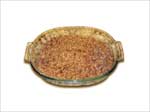 Natto is a Japanese fermented soy dish that can be made very easily from cooked soybeans. In order to make natto at home you will need a couple of things. First, you will have to obtain some cultured natto bacillus (Natto Kin) to add to some cooked soybeans. Simply obtain some frozen natto from an Asian market. The frozen natto will contain the live culture that you can use to innoculate your batch.
Natto is a Japanese fermented soy dish that can be made very easily from cooked soybeans. In order to make natto at home you will need a couple of things. First, you will have to obtain some cultured natto bacillus (Natto Kin) to add to some cooked soybeans. Simply obtain some frozen natto from an Asian market. The frozen natto will contain the live culture that you can use to innoculate your batch.
The second thing you will need is a thermostatically controlled device like a warming drawer or crock pot which can be set to 104°F – 105°F and will maintain a steady temperature for 24 hours to allow the live culture grow and reproduce so the natto will ferment properly.
Homemade Natto Ingredients:
- 1 lb whole organic soybeans, rinsed clean
- 12-14 cups water
- 1 45-50 gram packet frozen organic natto
Equipment and Supplies needed:
- Glass dish
- Mesh collander
- Large spoon
- Aluminum foil
- Plastic wrap
- Misc sanitizer like Star San
- Thermostatically controlled warming drawer or crock pot that can be set for 104°F – 105°F steady for 24 hours.
Make sure to buy organic soy beans and natto made from organic soybeans. Soy is probably the biggest GMO crop (genetically modified) so you want to insist on organically grown soy beans to avoid genetically modified organisms.
Weigh out a lb of soybeans. Rinse the beans and strain them with a mesh colander to clean them. Add the rinsed beans to a large stock pot. Add about 12-14 cups of water to the pot and then allow to soak overnight or about 8-12 hours. Place lid on pot and heat over high flame just until the water starts to boil, then turn the flame down and cook slowly over a low flame for about 6 hours until the beans are soft. Stir the pot occasionally with a wooden spoon. Cook very slowly over a low flame. After 6 hours the water level will drop considerably. Add water as necessary to keep it from boiling away.
Alternately, instead of slow cooking, steam the beans using a pressure cooker – 40 to 45 minutes.
Keep an eye on the pot because the soybeans will tend to foam up
all over the place. Stir frequently to break up the foam. After awhile it won’t foam so much, but you still have to keep the flame low and you should probably keep the pot partially covered to reduce the heat buildup. This helps to manage the foaminess.
About an 30 minutes to an hour before the soybeans are done, take the frozen pack of natto out of the freezer and allow it to thaw.
When the soybeans are close to finishing, use a sanitizer like Star San (available from homebrew beer supply store) to sanitize the glass dish, mesh collander and spoon – anything that will come into contact with the cooked beans once they leave the pot. Star San is supposed to be dilluted about one ounce per 5 gallons of water and is re-usable. It should keep for a few weeks. Consult the manufacturer for details.
Prepare the sanitizer in a 5 gallon or 6 gallon food grade plastic pail. It tends to get foamy but the foam is not a problem. Leave it. The foam will eventually go down. For less foam, add the water to a pail first, then add the Star San and stir it around to dissolve it. Place the glass dish, collander and spoon in the dilluted sanitizer. Allow to sit for a minute or two. Star San starts to sanitize upon contact. Remove the collander from the pail and place it in the sink. Remove the dish and spoon and turn them upside down in the sanitized collander to let them drip dry. DO NOT RINSE! It does not have to be totally dry. There will be no added taste from the sanitizer.
After the soybeans are cooked and softened, place the sanitized mesh collander into the sink. Pour the cooked beans into the collander to strain them. Use the sanitized spoon to spoon them out of the pot. Transfer the strained cooked soybeans as soon as possible. Remember to use the sanitized spoon. Break open the packet of thawed natto and stir it into the beans with the sanitized spoon. Mix thoroughly. Take a few minutes to stir everything up to spread the natto completely throughout the cooked beans.
Tear off a piece of aluminum foil big enough to cover the dish. Put some sanitizer in a spray bottle and spray the front and back of the foil, then place the foil over the dish and pinch down the edges all the way around. Using a sanitized fork or something sharp and pointed, poke holes in the foil to allow the natto to breathe during fermentation.
Set the temperature of a warming drawer or crock pot to 105°F. Place the dish into the warming drawer or crock pot and set a timer for 24 hours.
After 24 hours, remove the dish from the warmer and remove the foil covering the dish and replace it with a piece of plastic stretch wrap. Place the fermented natto in the refrigerator and allow to age for 7 days. After the 7 days the natto should be ready to eat.
Obtain some organic soy beans and weigh out one lb of them with a scale. You must insist on organic soybeans because virtually all soybeans that are not organic are most certainly genetically modified (GMO).
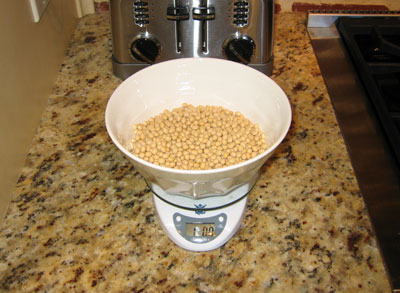
Add the soybeans to a cooking pot and rinse them under cold water to remove any dust.
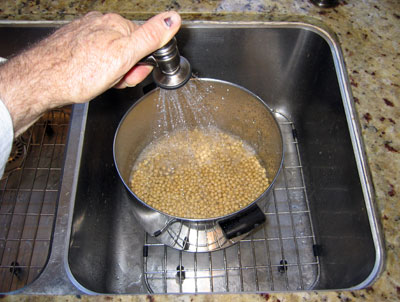
Strain them through a mesh collander after rinsing and add them back to the pot.
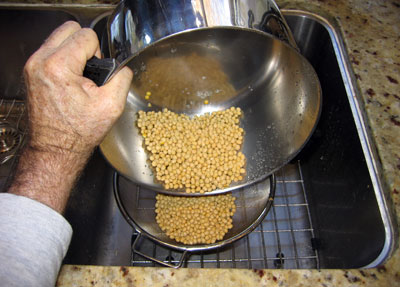
Add about 12-14 cups of water to the pot.
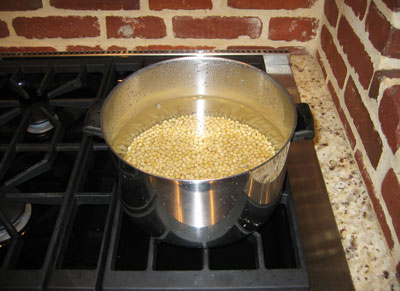
Put a lid on the pot and let the soybeans soak 8-12 hours or overnight.
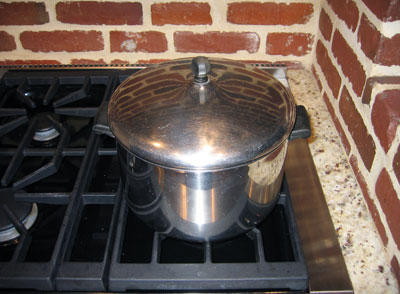
After soaking, cook over a high flame until the water begins to boil. You will see it start to foam up. Keep an eye on the pot because it can foam up all over the place and make a real mess. Turn the heat down to a low flame. Stir with a wooden spoon frequently and briskly to knock down the foam. Cook partially covered over a low flame for about 6 hours, stirring occasionally and adding water as needed to keep from boiling away all the water.
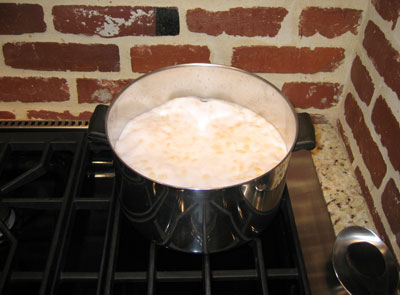
After about 6 hours the soybeans will be fully cooked and softened.
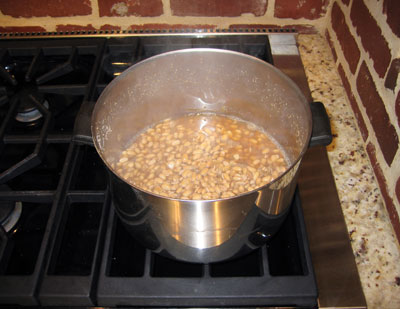
Obtain a sanitizing product like Star San (shown below) to sanitize the glass dish and other utensils. You sanitize everything to cut down on the possibility of introducing any bad bacteria. We only want the good bacteria to multiply. This product is available from homebrew beer supply stores. It is dilluted one oz. to 5 gallons of water. You simply dunk the items to sanitize into the solution, let it sit for a minute or two and then pull it out and allow it to drip dry for a few minutes. DO NOT RINSE!
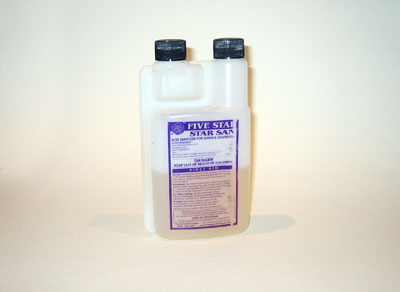
Shown below are the items to sanitize – a stainless steel mesh collander, a glass dish and a spoon. In the front row on the left is a pack of natto obtained from an Asian market.
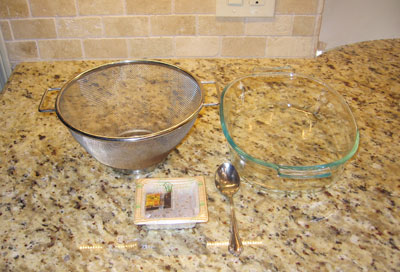
Completely submerge the mesh collander into a pail with the sanitizing solution. Allow it to sit for a minute or two, then pull it out and place it into the sink and let it drip dry. You can see a little foam in the sanitizing solution. Don’t worry.
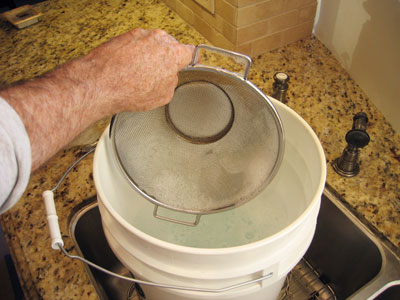
Repeat the same procedure for the glass dish and the spoon.
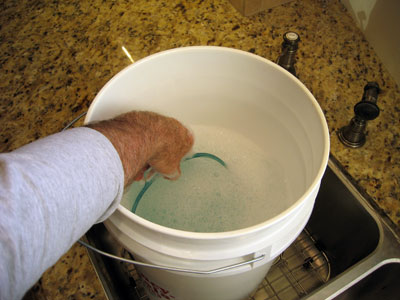
Place the sanitized dish and spoon upside down into the sanitized collander to allow them to drip dry. Sanitize everything about 5-10 minutes before the soybeans are done cooking to give them time to dry a little. They don’t have to be completely dry.
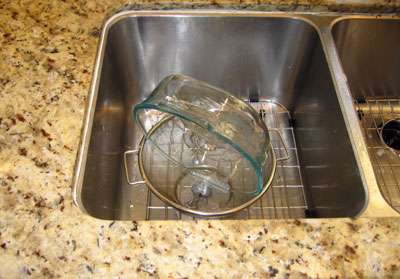
Remove the cooked beans from the stove and pour them into the sanitized collander to strain out all the liquid.
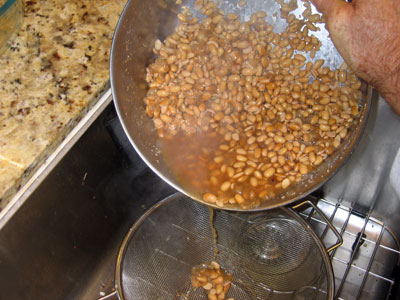
The strained, cooked soybeans are shown below.
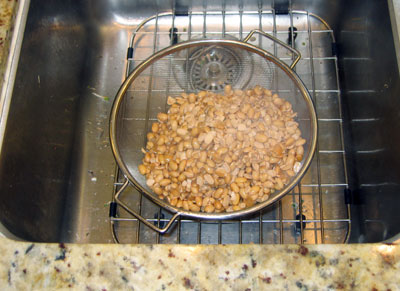
Next, pour the strained soybeans into the glass dish. Use the sanitized spoon if needed.
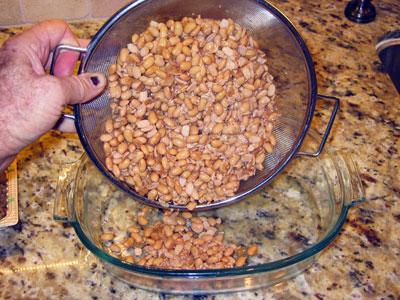
Open the pack of thawed natto.
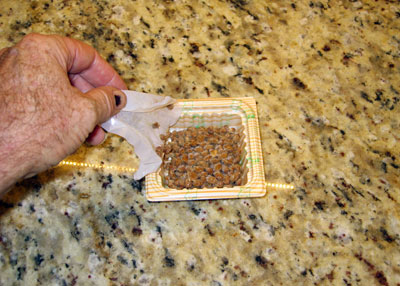
Using the sanitized spoon, add the natto to the cooked soybeans. Do it while the beans are still hot.
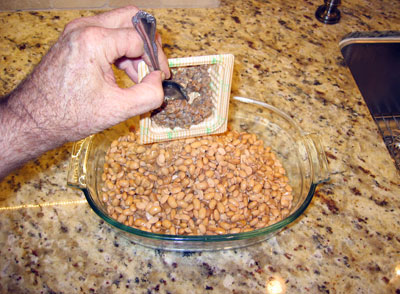
Stir thoroughly to mix everything up. Take a few minutes to do this. You want the natto to be distributed evenly all through the cooked soybeans. Just stir it up real good.
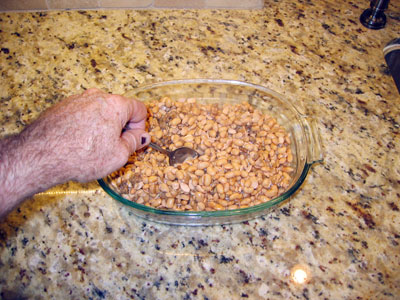
Add some of the sanitizing solution to a spray bottle.
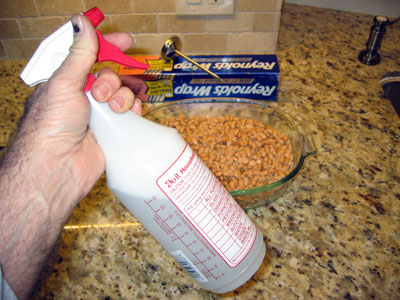
Tear off a piece of aluminum foil big enough to cover the dish. Spray it on both sides with the sanitizer.
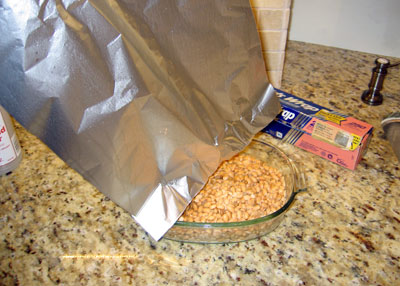
Cover the dish with the aluminum foil and crimp down the edges. Poke some holes into the foil to allow the natto to breathe while it is fermenting. Use a sharp object to poke the holes. I used a meat thermometer with a pointed probe. Sanitize it first before poking any holes.
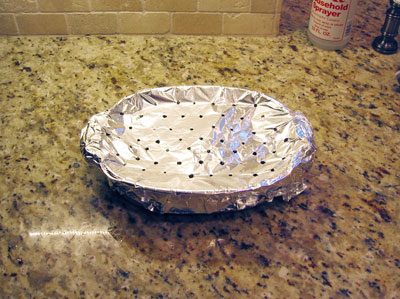
We are fortunate enough to have a good warming drawer that can be set for the time and temperature. Here I have set the warming drawer for 105°F and the timer for 24 hours and placed the foil covered dish onto the rack. Close the drawer and forget about it for 24 hours. The timer goes off after 24 hours and it sounds a chime and shuts down the heat. Pretty cool.
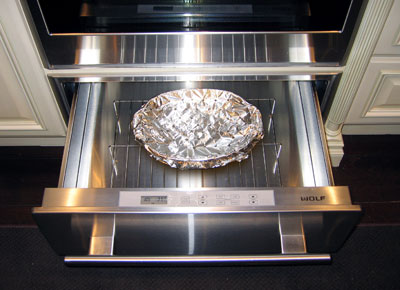
After 24 hours, remove the dish from the warming drawer or crock pot and remove the foil. Don’t touch it yet.
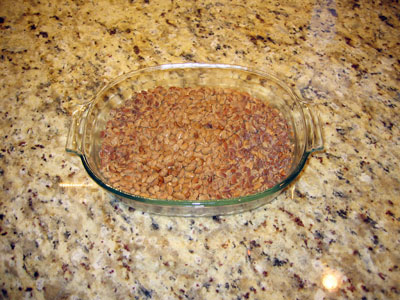
Here’s a closeup of the natto after fermentation.
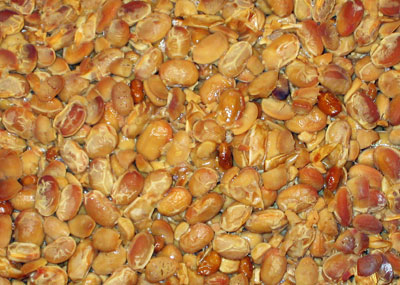
Cover the dish with plastic stretch wrap and put it in the refrigerator and allow to age for 7 days. After 7 days the natto will be ready to eat. You can freeze some of it if it can’t be completely consumed before going bad.
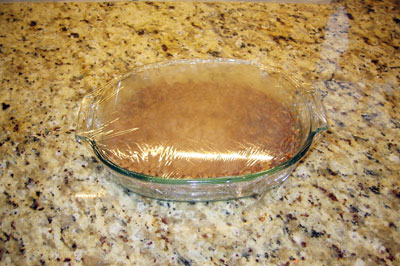
Thank you! This has been a great help, since I haven´t made natto in years. Thank you for the high level of detail.
I loved how you used organic soy beans. Going organic is very important with soy beans.
I liked that you used wooden spoon. Wood is the best.
A note of caution, though: I would not, repeat NOT, use a commercial sanitizer, let alone Star San.
> is of no consequence.
No, it is not. Unfortunately.
The taste is not the problem. The ingredients in Star San are toxic to aquatic life and to human life, see this for more:
https://www.piwine.com/media/Products/Safety-Data-Sheets/SDS-STARSAN.pdf
To sanitize utensils, you can simply pour hot water from the beans over whatever that is that you want sanitized. (Wood pretty much sanitizes itself after being washed with glycerin-containing natural soap in water.)
I would also refrain from using aluminum foil and plastic. You can cover the beans with a wet towel, it works a lot better and does not damage your brain the way aluminum can. (Tinnitus, anyone? That’s aluminum responding to EMF radiation).
Love!
Wow! Thanks! This is awesome. I appreciate your comments very much.